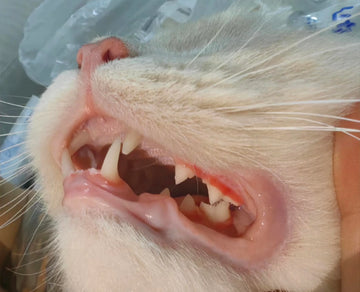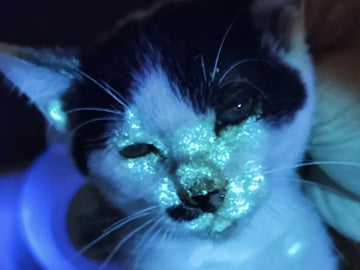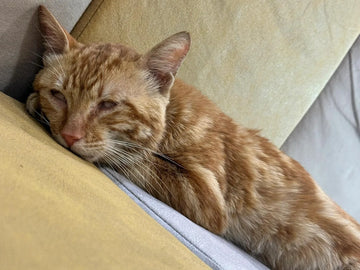Author: Attending Veterinarian · Updated Oct 2025 · Read time ~20 minutes
As a practicing veterinarian I see cats with mouth pain every week. Owners often use the words "bad breath" or "drooling" and expect a simple fix—sometimes it is simple, sometimes it's not. The three conditions most commonly confused are gingivitis, periodontitis, and stomatitis. They overlap but have different causes, diagnostic paths, and treatments. In this guide I’ll explain how to tell them apart, what tests we perform, how we treat each condition in clinic, the risks when disease is left untreated, and practical steps owners can take at home and during holidays or travel. My tone is clinical but practical—this is what I tell my clients when their cat walks in with a sore mouth.
Table of Contents
Overview: definitions & why distinction matters
Clinical signs: what owners usually notice
How we diagnose: exam, anesthesia, radiographs, biopsy & labs
Gingivitis — cause, treatment & prognosis
Periodontitis — what it is and how we manage it
Stomatitis (chronic gingivostomatitis): a different disease
Systemic risks & long-term consequences
Treatment strategies: medical, surgical, supportive care
Home care, nutrition & prevention
Costs, timeline & what to expect at the clinic
Holiday tips (US long weekends & emergencies)
FAQ & quick clinical checklist
Further reading & internal links
Overview: definitions & why distinction matters
In practice the three terms point to related but distinct processes:
- Gingivitis — inflammation limited to the gum margin (gingiva). It is reversible if the source (plaque, tartar) is removed.
- Periodontitis — progression of gingivitis where inflammation extends below the gum line, causing bone and ligament loss around the tooth. This is often irreversible and can cause tooth loosening and abscesses.
- Stomatitis (feline chronic gingivostomatitis) — a severe, often immune-mediated inflammation that affects gum and multiple areas of oral mucosa (tonsils, cheeks, tongue). It is more than dental plaque alone and typically needs systemic management or extractions for control.
Why this matters: gingivitis is usually managed with dental cleaning and home care; periodontitis often requires extractions and sometimes antibiotics; stomatitis may require immunomodulation and partial or full-mouth extractions. The wrong treatment delays recovery and increases cost and suffering.
Clinical signs: what owners usually notice
Cats are masters at hiding pain. Owners usually notice subtle changes before the cat clearly acts "sick." Here are the common signals I advise clients to watch for:
- Reduced appetite or picky eating — avoids dry kibble or drops small pieces from the mouth.
- Bad breath (halitosis) — often the first complaint, but not diagnostic by itself.
- Drooling, pawing at the mouth, or facial rubbing.
- Weight loss — particularly important in indoor-only cats where weight should be stable.
- Red, bleeding gums or visible tartar — direct visual clues, but absence of visible signs doesn't mean no disease.
- Behavioral changes — irritability, hiding, decreased grooming, or increased vocalization during feeding.
If your cat shows facial swelling, discharge from a tooth root, or sudden inability to eat, seek veterinary attention promptly—these are signs of advanced infection or abscessation.

How we diagnose: oral exam, anesthesia, radiographs, biopsy & labs
A proper diagnosis usually requires a combination of awake assessment and a full oral exam under anesthesia. Why anesthesia? Many important findings—pocketing, recession, mobility, and subgingival tartar—are invisible when the cat is awake and stressed.
1. Awake history & exam
We start with history: diet, appetite, prior dental care, drooling, duration, and any response to previous antibiotics or steroids. Then a gentle awake oral check to note obvious tartar, ulcers, or swollen areas.
2. Assessment under anesthesia
Under anesthesia we probe periodontal pockets, grade mobility, measure gingival recession, chart every tooth, and look for ulcers or mucosal changes beyond the gingiva. This is also when dental radiographs (intraoral X-rays) are taken. Radiographs tell us whether bone is being lost around roots — the hallmark of periodontitis.
3. Diagnostic imaging
Intraoral dental radiographs are essential. They show bone loss, root resorption, endodontic disease, retained root fragments, and abscesses that are hidden clinically.
4. Tissue biopsy & lab tests (when stomatitis suspected)
If the pattern suggests stomatitis (severe mucosal inflammation, ulceration, bilateral lesions, and poor response to conventional therapy), we often take biopsies to rule out neoplasia, eosinophilic disease, or infectious causes. We also screen for underlying systemic contributors: FeLV and FIV testing, CBC and chemistry (to assess anesthetic risk and look for systemic disease) and sometimes cultures if an abscess or unusual infection is suspected.
5. What radiographs reveal
- Horizontal or vertical bone loss (periodontitis).
- Periapical lucencies (tooth root abscess).
- Resorptive lesions or retained roots.
A definitive treatment plan relies heavily on these diagnostic steps—skipping radiographs is like treating an infected hip without an X-ray.
Gingivitis — cause, treatment & prognosis
Cause: plaque accumulation at the gingival margin causes a localized inflammatory response. Diet, salivary composition, and host immune response influence severity. Gingivitis is common and reversible if addressed early.
Clinical signs
- Red, swollen gum margins (gingival sulcus).
- Sometimes minor bleeding when touched or on brushing.
Treatment approach
- Professional dental cleaning under anesthesia: scaling to remove supra- and subgingival plaque and calculus, followed by polishing. This addresses the underlying irritant.
- Home care: tooth brushing with feline toothpaste, dental diets or dental-specific chews, and dental rinses as recommended.
- Short course antibiotics or anti-inflammatories: occasionally used if there is secondary infection or significant inflammation; these are adjunctive.
Prognosis
With proper cleaning and consistent home care, gingivitis usually resolves. Early intervention prevents progression to periodontitis.
Periodontitis — what it is and how we manage it
Periodontitis occurs when bacterial invasion and inflammation extend into the periodontium (bone and periodontal ligament), resulting in irreversible destruction. It is the most common cause of tooth loss in adult cats.
Signs & diagnostics
- Deep periodontal pockets on probing.
- Radiographic bone loss around roots.
- Tooth mobility or shifting.
- Occasionally, facial swelling if there is a draining tract or abscess.
Treatment
- Tooth-specific therapy: extraction of teeth with severe bone loss. In cats, extractions are often the most humane and effective solution when roots are diseased; root planing and periodontal surgery are possible but less commonly practical in feline patients.
- Local therapy: subgingival curettage and antiseptic irrigation during the dental procedure.
- Systemic therapy: antibiotics for documented infection or severe periodontal disease; pain control and short-course anti-inflammatories as needed.
- Follow-up care: recheck radiographs and clinical exams, and a robust home dental program to protect remaining teeth.
Prognosis
Periodontitis is progressive if untreated. Extractions halt pain and infection and improve quality of life; remaining teeth require vigilant home care to slow further disease.
Stomatitis (chronic gingivostomatitis): a different disease
Feline chronic gingivostomatitis (FCGS) is a frustrating, painful condition characterized by severe inflammation of gingiva and oral mucosa beyond the gum margins — often bilateral, symmetrical, and disproportionately severe compared to the amount of dental plaque present. The current consensus is that it represents an inappropriate immune response to oral antigens (bacterial biofilm, viral infections such as calicivirus, or other triggers), not simply "bad teeth."
Clinical picture
- Very red, ulcerated, friable mucosa often involving the caudal oropharynx (tonsillar area), cheeks, and tongue.
- Marked pain, hypersalivation, drooling, and severe anorexia or hyporexia.
- Often poor response to routine dental cleaning alone.
Diagnostic approach
We exclude systemic disease (FeLV/FIV), perform thorough dental radiographs, and often biopsy suspicious areas. History of recurrent stomatitis or poor response to cleaning raises suspicion for FCGS.
Treatment options
- Extraction-based therapy: in many clinics, partial or full-mouth extractions (removal of premolars/molars and sometimes all teeth) are offered. In an important percentage of cases, extraction significantly reduces inflammation and pain by removing the chronic antigenic stimulus (dental plaque and roots).
- Medical therapy: systemic immunomodulatory drugs — corticosteroids for short-term control, cyclosporine A for longer-term immune modulation, or newer agents (e.g., interferon, monoclonal antibodies) depending on availability and case specifics.
- Antibiotics: used when secondary infection is documented; they are not definitive therapy for the immune-mediated component.
- Pain control: multimodal analgesia is critical — opioids, NSAIDs (if safe), and local nerve blocks intraoperatively.
Prognosis
Stomatitis is a chronic disease; many cats improve dramatically after appropriate extractions combined with medical therapy, but some require ongoing immunomodulation. Early specialist referral improves outcomes.
Systemic risks & long-term consequences
Oral disease is not just about bad breath. Untreated dental disease and stomatitis carry systemic implications:
- Chronic pain & weight loss: Cats who cannot eat comfortably lose weight and condition.
- Spread of infection: Periodontal pathogens can seed distant sites; there is evidence in people and animals that chronic oral infection can influence kidney and heart disease. In cats we monitor bloodwork when chronic inflammation is present.
- Reduced quality of life: ongoing pain alters behavior, grooming, and social interaction.
Complex cases may overlap with other diseases—if you’ve managed a chronic disease such as FIP or systemic infections, coordinate dental plans with your specialty team. Read more about systemic illnesses that can complicate oral disease in cats in our Cat’s FIP post; while FIP is different from stomatitis, the lesson is the same: systemic illness changes dental risk and care strategy.
Treatment strategies: medical, surgical, and supportive care
Successful management begins with accurate diagnosis and an individualized plan. Below is a high-level roadmap I use in practice.
1. Acute control & pain management
- Analgesics (opioids, local blocks) immediately for painful cats.
- Antibiotics when there is systemic illness, abscesses, or bacteremia risk — based on culture where possible.
2. Definitive dental therapy under anesthesia
Every cat with evidence of periodontal disease or stomatitis benefits from a comprehensive dental procedure: charting, scaling (sub- and supra-gingival), polishing, probing, intraoral radiographs, and targeted extractions. I counsel owners that thorough treatment and radiographs reduce the chance of persistent pain and re-treatment later.
3. Post-op & long-term medical therapy
- Short course of antibiotics when indicated, anti-inflammatories as needed, and specialist-level immunomodulators for stomatitis.
- For stomatitis, cyclosporine has evidence supporting remission in many cats; newer biologics are emerging but require specialty discussion.
4. Recheck schedule
I recheck at 2 weeks (wound healing, pain control), 6–8 weeks (clinical response and weight), and then periodically (every 6–12 months) with dental radiographs when widespread disease was present.
Home care, nutrition & prevention
Home care is the single most powerful tool to prevent gingivitis and slow periodontitis. For stomatitis, home care supports comfort but does not replace professional intervention.
Daily toothbrushing
Brush daily with a feline toothpaste and a soft brush. It’s the gold standard. Start slowly, create a positive routine, and celebrate small wins.
Dental diets & water additives
Veterinary dental diets and some clinically tested oral rinses reduce plaque accumulation. They are helpful adjuncts but not replacements for brushing.
Nutrition & immune support
High-quality nutrition supports healing. In mouth pain, switch to canned or softened diets temporarily. If your cat has repeated stomatitis episodes, discuss immune-nourishing strategies with your veterinarian.
Regular professional cleanings
Annual or biannual cleanings are appropriate for many cats, especially as they age. Frequency depends on individual risk factors.

Costs, timeline & what to expect at the clinic
Prices vary by region and clinic; below are typical U.S. ranges to help you plan. Exact quotes are provided by your clinic after diagnosis.
| Service | Typical U.S. cost (range) | Notes |
|---|---|---|
| Initial exam & diagnostics | $75–$200 | Includes awake exam, routine bloodwork |
| Comprehensive dental under anesthesia | $300–$900+ | Scaling, polishing, radiographs; varies with extent |
| Extractions (per tooth) | $50–$300 per tooth | Complex root anatomy increases cost |
| Biopsy & histopathology | $150–$400 | Used when stomatitis or neoplasia suspected |
| Immunomodulatory drugs (e.g., cyclosporine) | $50–$200/month | Variable by dose and brand |
| Follow-up & radiographs | $80–$250 | Per recheck |
Many clinics offer payment plans or estimate-based financing for extensive dental work. Discuss financial options with your hospital team early—delaying care often increases total cost and suffering.
Holiday tips (US long weekends: July 4, Thanksgiving, Christmas)
- Schedule elective dental procedures outside major holidays when emergency coverage may be limited.
- Refill chronic medications (e.g., cyclosporine) a week early if holidays are upcoming.
- If a cat shows sudden anorexia or face swelling during a holiday, call your clinic for emergency options; many areas have 24/7 emergency hospitals but wait times can be long.
FAQ & quick clinical checklist
Q: Is stomatitis contagious to other cats?
A: Stomatitis itself is not a classic contagious disease like ringworm or feline calicivirus; it is an immune-mediated response. However, underlying infectious agents (calicivirus, Bartonella, or others) can spread between cats. Always isolate symptomatic new cats until evaluated.
Q: Can poor dental health affect kidneys?
A: Chronic inflammation may contribute to systemic effects; while direct causation is complex, we monitor kidney values in older cats with advanced oral disease.
Q: My cat won't let me brush — now what?
A: Start with short sessions, offer treats, use finger brushes, and consider veterinary-strength dental chews or diets as adjuncts. For high-risk cats, professional cleanings are crucial.
Q: How soon after dental extractions will my cat eat normally?
A: Many cats eat within 24–72 hours post-op when pain is controlled, but cats with severe stomatitis may take longer. Use palatable canned foods and ensure adequate analgesia as prescribed.
Q: Should I worry about other infections like gastroenteritis when my cat has mouth disease?
A: Oral disease can suppress appetite and lead to secondary GI sensitivity. For primary GI issues see our Cat Gastroenteritis guide. Also, screen for systemic infections (FeLV/FIV) when appropriate.
Further reading & internal resources
- Ringworm — identification and home steps (different infectious disease but useful for household infection control).
- Cat’s FIP (systemic disease overview — consult if systemic illness suspected).
- Cat Safety at Home (practical home-proofing and emergency prep).




